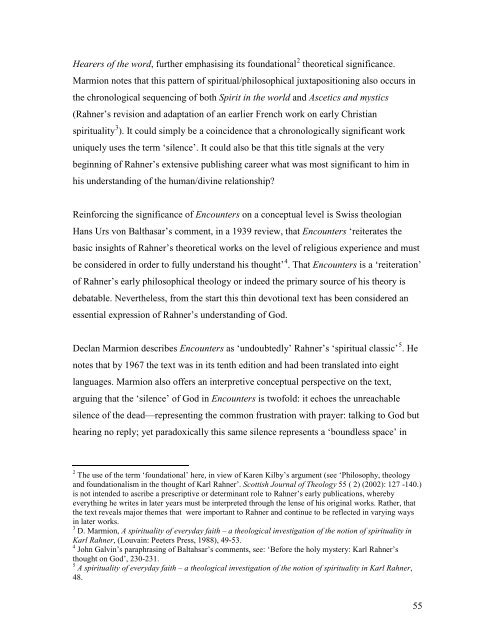Introductory notes for readers of this thesis - Theses - Flinders ...
Introductory notes for readers of this thesis - Theses - Flinders ...
Introductory notes for readers of this thesis - Theses - Flinders ...
Create successful ePaper yourself
Turn your PDF publications into a flip-book with our unique Google optimized e-Paper software.
Hearers <strong>of</strong> the word, further emphasising its foundational 2 theoretical significance.Marmion <strong>notes</strong> that <strong>this</strong> pattern <strong>of</strong> spiritual/philosophical juxtapositioning also occurs inthe chronological sequencing <strong>of</strong> both Spirit in the world and Ascetics and mystics(Rahner’s revision and adaptation <strong>of</strong> an earlier French work on early Christianspirituality 3 ). It could simply be a coincidence that a chronologically significant workuniquely uses the term ‘silence’. It could also be that <strong>this</strong> title signals at the verybeginning <strong>of</strong> Rahner’s extensive publishing career what was most significant to him inhis understanding <strong>of</strong> the human/divine relationship?Rein<strong>for</strong>cing the significance <strong>of</strong> Encounters on a conceptual level is Swiss theologianHans Urs von Balthasar’s comment, in a 1939 review, that Encounters ‘reiterates thebasic insights <strong>of</strong> Rahner’s theoretical works on the level <strong>of</strong> religious experience and mustbe considered in order to fully understand his thought’ 4 . That Encounters is a ‘reiteration’<strong>of</strong> Rahner’s early philosophical theology or indeed the primary source <strong>of</strong> his theory isdebatable. Nevertheless, from the start <strong>this</strong> thin devotional text has been considered anessential expression <strong>of</strong> Rahner’s understanding <strong>of</strong> God.Declan Marmion describes Encounters as ‘undoubtedly’ Rahner’s ‘spiritual classic’ 5 . He<strong>notes</strong> that by 1967 the text was in its tenth edition and had been translated into eightlanguages. Marmion also <strong>of</strong>fers an interpretive conceptual perspective on the text,arguing that the ‘silence’ <strong>of</strong> God in Encounters is tw<strong>of</strong>old: it echoes the unreachablesilence <strong>of</strong> the dead—representing the common frustration with prayer: talking to God buthearing no reply; yet paradoxically <strong>this</strong> same silence represents a ‘boundless space’ in2 The use <strong>of</strong> the term ‘foundational’ here, in view <strong>of</strong> Karen Kilby’s argument (see ‘Philosophy, theologyand foundationalism in the thought <strong>of</strong> Karl Rahner’. Scottish Journal <strong>of</strong> Theology 55 ( 2) (2002): 127 -140.)is not intended to ascribe a prescriptive or determinant role to Rahner’s early publications, wherebyeverything he writes in later years must be interpreted through the lense <strong>of</strong> his original works. Rather, thatthe text reveals major themes that were important to Rahner and continue to be reflected in varying waysin later works.3 D. Marmion, A spirituality <strong>of</strong> everyday faith – a theological investigation <strong>of</strong> the notion <strong>of</strong> spirituality inKarl Rahner, (Louvain: Peeters Press, 1988), 49-53.4 John Galvin’s paraphrasing <strong>of</strong> Baltahsar’s comments, see: ‘Be<strong>for</strong>e the holy mystery: Karl Rahner’sthought on God’, 230-231.5 A spirituality <strong>of</strong> everyday faith – a theological investigation <strong>of</strong> the notion <strong>of</strong> spirituality in Karl Rahner,48.55















